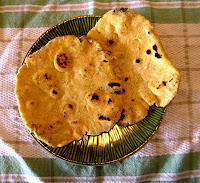 Buckwheat is another one of those gluten-free "supergrains." Actually, buckwheat is a fruit seed. So does that make it a "super flower seed"? Whatever it is, buckwheat is a nutritious food. The protein found in buckwheat contains the eight essential amino acids. It's rich in B vitamins as well as phosphorous, magnesium, iron, zinc, copper and manganese. Buckwheat also gets credit for being high in fiber and flavenoids, and a good oil source of Alpha-Linolenic Acid (an essential fatty acid). If that isn't enough, it helps lower blood pressure and glucose levels, and reduces cholesterol. Sounds like everyone should be eating it instead of wheat. Some places where it is widely cultivated and consumed are China, Russia, Poland, Canada and France.
Buckwheat is another one of those gluten-free "supergrains." Actually, buckwheat is a fruit seed. So does that make it a "super flower seed"? Whatever it is, buckwheat is a nutritious food. The protein found in buckwheat contains the eight essential amino acids. It's rich in B vitamins as well as phosphorous, magnesium, iron, zinc, copper and manganese. Buckwheat also gets credit for being high in fiber and flavenoids, and a good oil source of Alpha-Linolenic Acid (an essential fatty acid). If that isn't enough, it helps lower blood pressure and glucose levels, and reduces cholesterol. Sounds like everyone should be eating it instead of wheat. Some places where it is widely cultivated and consumed are China, Russia, Poland, Canada and France.Get acquainted with buckwheat and its health benefits by giving some of my Day 4 recipes a try.
Shopping List: buckwheat groats (Kasha), buckwheat flour, buckwheat soba noodles, cherries, apples, pears, sweet potatoes, bok choy, Swiss chard, broccoli, cauliflower, kale, shrimp, pollock.
Hot Apple Kasha or Bengali Buckwheat: see picture posted December 28
(for one serving)
1 tsp. olive oil
1/4 cup kasha
1/2 tsp. fennel seeds
1/2 tsp. cardamon seeds or coriander seeds
1/2 peeled, diced apple
1 cup water
1 T. apple juice concentrate
1/4 tsp. ground cinnamon
Heat olive oil in a heavy saucepan. Add kasha (buckwheat groats) and seeds. Toast for a few minutes, stirring the kasha and seeds. Add the water with apple juice concentrate and other ingredients. Bring to a boil. Cover and simmer for about 12-15 minutes or until moisture is absorbed. Serve with milk, additional cooked apples, walnuts or almonds.
Shrimp and Broccoli over Soba Noodles

Note: Soba noodles are a delicious way to get your buckwheat.
Recipe serves 2
2 cups cooked soba noodles
1 T. dry sherry
3/4 cup paprika
2 garlic cloves, minced
1-2 T. Chinese chili sauce (less if you don't like the heat)
3/4 pounds shrimp, peeled and deveined
2 T. water
1 tsp. cornstarch
1 tsp. sugar
1/2 tsp. salt
1 T. vegetable oil
1 1/2 cups broccoli florets
2 cups chopped bok choy
salt and black pepper to taste
Bring a pot of salted water to boil. Add the soba noodles and cook until tender. Drain.
Place the shrimp in a bowl with the sherry, paprika, garlic and chili sauce. Stir to coat, cover and refrigerate for at least 30 minutes or longer. In a small bowl or measuring cup, combine the water, cornstarch, sugar and salt. Set aside. Heat the oil in a large skillet or wok. Add the broccoli and bok choy. Stir fry for several minutes until veggies are tender crisp. Add the shrimp mixture; stir fry to another 5 minutes until the shrimp are pink and opaque. Add the cornstarch mixture and bring to a boil. Cook for one minute or until the sauce thickens. Add the soba noodles, stir to combine. Remove from heat and serve.




 The rotation diet has forced me to incorporate more alternative grains into my menus. I've discovered a whole new world of grains with quinoa, amaranth and buckwheat (kasha). These gluten-free grains are actually superfoods nutritionally. Quinoa, the grain I plan my meals around for Day 1, is an ancient grain with origins tracing to the Andes Mountains of South America. It was one of three staple foods, along with corn and potatoes, of the Inca civilization. Quinoa (pronounced "Keen-wa") contains more protein than any other grain, an average of 16.2 percent, which means it rivals the protein content of meat. It's also a complete protein with an essential amino acid balance close to ideal. It's a versatile grain as I've come to find out. Each time I sample a new recipe it leaves me begging for more just like Pumpkin, my orange kitty, at the right. Recipes and menu plans for Day 1, a new round, which features quinoa, are below. Other key ingredients for these meals are safflower oil, mushrooms, lettuce, zucchini, peas, beets, kiwi, blueberries and starfruit.
The rotation diet has forced me to incorporate more alternative grains into my menus. I've discovered a whole new world of grains with quinoa, amaranth and buckwheat (kasha). These gluten-free grains are actually superfoods nutritionally. Quinoa, the grain I plan my meals around for Day 1, is an ancient grain with origins tracing to the Andes Mountains of South America. It was one of three staple foods, along with corn and potatoes, of the Inca civilization. Quinoa (pronounced "Keen-wa") contains more protein than any other grain, an average of 16.2 percent, which means it rivals the protein content of meat. It's also a complete protein with an essential amino acid balance close to ideal. It's a versatile grain as I've come to find out. Each time I sample a new recipe it leaves me begging for more just like Pumpkin, my orange kitty, at the right. Recipes and menu plans for Day 1, a new round, which features quinoa, are below. Other key ingredients for these meals are safflower oil, mushrooms, lettuce, zucchini, peas, beets, kiwi, blueberries and starfruit.












